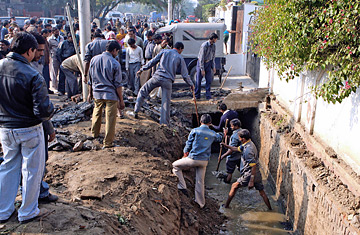
Workers and Police hunt for evidence including body parts in a drain in Noida, on the outskirts of New Delhi, following the arrest of two suspected serial killers.
Three of the victims lived on the same floor of the same run-down apartment building in Nithari and one had been reported missing for nearly two years. Yet not once did the police come to the building to investigate the disappearances. Many of the victims were pretty young women like Bina Halder, 13, who vanished on March 15, 2005. She had been working as a maid in order to raise enough money for a dowry that would allow her a marriage good enough to escape the neighborhood. But when her mother, Aloki Halder, went to the police to report her disappearance, they laughed and suggested that her daughter had simply run off with a man. She said the police lectured her, saying, "If you can't keep track of your children, don't have so many."
If the police had asked questions, they might have spoken to a reclusive woman named Maya Sarkar, who lived on the same floor, knew most of the victims and worked as a maidservant at the three-story home of Moninder Singh Pandher, a businessman. Pandher and his servant Surender Kohli have now been arrested and charged with kidnapping, raping and killing the victims. Maya Sarkar is finally being questioned by the police.
Thirty-eight young women and children have gone missing from Nithari slum since February 2005. Fifteen of them, including Bina, have since been identified by body parts and clothing found at the house. Many of the victims' torsos still have not been found, leading some investigators to speculate that the internal organs may have been harvested and sold. Dr. Vinod Kumar, who presided over some of the post-mortem investigations, remarked that the skulls seemed to have been removed from the bodies with medical precision. Photographs of Pandher posing with nude children, including one where he appears to be watching a dance performed by young, naked boys, have also been recovered at the house. Police are looking for connections to international child pornography rings.
Pandher's servant Kohli has confessed to the killings, according to police. But an Indian public that has seen the rich literally get away with murder in the past may not want the investigation to stop there. Investigators have subjected both Kohli and Pandher to treatments of sodium pentathol, or truth serum, even though any evidence gathered under such conditions is imprecise and cannot be used in a court of law. Kohli has admitted under the influence of the drug that he consumed the livers of his victims, a chilling detail that has earned him the nickname Noida's Hannibal Lecter. Criminal psychologists caution that he may just be exaggerating his crimes for notoriety or some other reason. In press reports, Pandhar's son Karan has defended his father, saying, "He is just a suspect. He is not a monster."
Still, if the police had kept better track of what was going on in the slum, the House of Horrors might never have existed. "What if the police investigated when Bina first went missing?" asks the uncle of victim Aladi Halder, who lived across the hall from Bina's family. "Maybe then all of our children would still be here, living with us."
With reporting by Indrani Ghosh Nangia.
